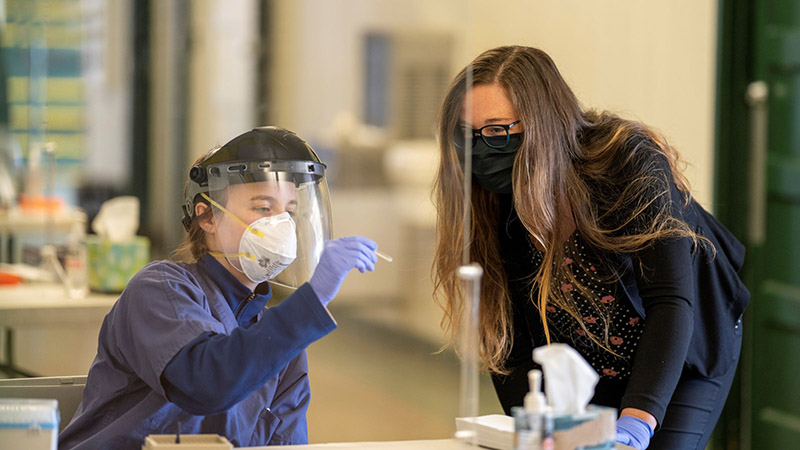This website uses cookies so that we can provide you with the best user experience possible. Cookie information is stored in your browser and performs functions such as recognising you when you return to our website and helping our team to understand which sections of the website you find most interesting and useful.

There’s no denying that an education in science, technology, engineering and mathematics (STEM) paves the way to a bright future. A future where STEM leaders tackle some of the world’s greatest and most demanding problems.
The global demand for STEM leaders remains at an all-time high. According to SHRM, an estimated 3.5 million STEM jobs will remain unfilled by 2025. This means there is no shortage of jobs for students seeking to make a career in STEM. In fact, the career trajectories of a STEM education are impressive: STEM jobs are projected to grow 8.8% between 2017 and 2029 with the average median hourly wage for STEM jobs US$38.85.
Get your start at these top universities:
Simon Fraser University
When Bao Williamson first joined Vancouver’s Simon Fraser University, she was unsure where studying environmental science would lead her. Then, she discovered the university’s leading edge in experiential learning. She joined the co-op program and completed placements with Environment Canada’s meteorology department and wildlife service. Her skills and network flourished; job opportunities knocked. This summer, Williamson graduated with a BSc in Environmental Science, a certificate in Geographic Information System (GIS) and a job with Apex Systems.
Simon Fraser University is recognised worldwide for its successful graduates in green careers. Rankings reflect this. The university has been ranked #1 comprehensive university in Canada for the past 13 out of 14 years, with its Environmental Science program noted as a “standout program.” It has joined the UN’s Race To Zero, in support of the global effort to act on climate change, and currently ranks eighth in the world for impact on sustainable cities and communities.
These accolades speak for themselves, but what really sets Simon Fraser University’s Environment programs apart, is how its students learn through action. They complete research or project work with a professor, forming a solid understanding in their academic field and then apply it to real-world problems gaining relevant skills and making new connections.
Pair this with quality programs, and students are set for a promising career in the environmental field. At the Faculty of Environment, you can pursue a BSc in Environmental Science, a Bachelor of Environment in Resource and Environmental Management, a BSc in Physical Geography, or a Bachelor of Environment in Global Environmental Systems, to name a few. Whichever program you choose, you’ll receive a very interdisciplinary education, through a unique sharing of knowledge which is critical when looking for solutions to complex problems. The result? Changemakers ready to build a better world. Learn more here.
University of Oregon

The University of Oregon is a hub for learning, research and academic excellence. Source: University of Oregon Facebook
Zoom in on the state of Oregon, and you’ll discover the lush Willamette Valley, just a short drive from the Pacific Ocean and the Cascade Mountains. Beneath the beauty of it all lies the University of Oregon (UO), a renowned institution committed to research and teaching.
The College of Arts and Sciences is just as prolific. A hub for learning, research, and academic excellence, the college is a driving force for UO. It conducts high-output, high-impact research activity, earning the college a University of Oregon membership in the prestigious Association of American Universities (AAU).
At this world-class faculty with cutting-edge facilities, the science departments are as excellent and passionate. They create and disseminate new knowledge in their fields by combining research and training for students.
With quality teaching comes rigorous programs. Here, aspiring scientists pursue natural sciences programs in different fields. These include Biology, Chemistry and Biochemistry, Computer and Information Technology, Data Science, Earth Sciences, Multidisciplinary Science, Human Physiology, Mathematics, Neuroscience, Physics and Psychology.
Choose any of the programs, and you’ll come to know that discovery-oriented learning at UO is the norm. Students get involved, gain experience, and explore the greater world. They train to become part of the next generation of scientists who will push the frontiers of human knowledge.
Texas A&M University

Affordable tuition fees, excellent campus life and valuable education. Source: Texas A&M University Facebook
As the state’s first public institution of higher learning, Texas A&M University is a research-intensive institution in Aggieland, Texas. Over 70,000 students pursue an education here, and for good reasons: affordable tuition fees, excellent campus life, valuable education and some of the best faculties in the world. The best part? The university strives to continuously improve in all kinds of ways.
Step foot into its College of Arts and Sciences, and you’ll discover that the sentiment is especially true. It brings three colleges — Geosciences, Liberal Arts, and Science — together, becoming the hub for vast resources and exemplary programming. It houses many departments, one of which is the Department of Geography.
“Geographic information science and technology (GIST) is one of the cornerstones of modern data-driven applications, modelling and decision-making. The GIS job market is booming. In science and technology fields, GIS skills give Aggies a leg-up on the competition,” shares Associate Professor in Geography Dr. Dan Goldberg.
The department offers major and minor programs related to geography. This includes a BS in Geography and BS in Geographic Information Science and Technology. Graduate Leslie Vallecillo pursued the BS in Geographic Information Science and Technology, and despite her challenging academic journey, she has no regrets. “Two years ago, I was on academic probation and feeling lost, but now I’m here, celebrating my first-generation accomplishments and about to graduate,” says Vallecillo.
University of North Carolina at Chapel Hill

At the University of North Carolina at Chapel Hill, students become scientists who tackle current and future environmental and resource challenges. Source: University of North Carolina at Chapel Hill
For aspiring earth, marine and environmental scientists, look no further than the University of North Carolina at Chapel Hill (UNC-CH). Here, the Department of Earth, Marine and Environmental Sciences (EMES) achieves excellence in every sense of the word. Launched on July 1, 2021, EMES was a merger of three units. Dean of the College Terry Rhodes believed that the merger would strengthen interdisciplinary research, expand curricular offerings and promote experiential learning opportunities for students.
“Bringing together the study of earth and ocean sciences takes advantage of the natural connections between the existing programs and allows us to build on our strengths,” says Rhodes. “It will not only elevate the groundbreaking research we conduct at UNC-CH, but it will also provide new degree offerings for our students, as well as more opportunities, to engage in hands-on research, including at the stellar Institute of Marine Sciences facility in Morehead City.”
Indeed, with the merger, EMES understands the earth and ocean processes that govern our planet, shape diverse ecosystems, sustain life and drive environmental change. Students are equipped with a strong science foundation, critical thinking skills and interdisciplinary perspectives.
Not convinced? Have a look at any of its majors and minors, from geological sciences in earth science concentration and environmental science concentration to marine science minors. For postgraduates, check out the master’s and PhD in marine sciences and geological sciences. These programs promote exploration and discovery of the natural world through research-based learning. Students become scientists who tackle current and future environmental and resource challenges.
*Some of the institutions featured in this article are commercial partners of Study International








